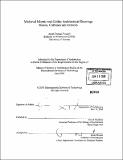| dc.contributor.advisor | David Friedman. | en_US |
| dc.contributor.author | Etemad Yousefi, Arash | en_US |
| dc.contributor.other | Massachusetts Institute of Technology. Dept. of Architecture. | en_US |
| dc.date.accessioned | 2006-06-19T17:33:26Z | |
| dc.date.available | 2006-06-19T17:33:26Z | |
| dc.date.copyright | 2005 | en_US |
| dc.date.issued | 2005 | en_US |
| dc.identifier.uri | http://hdl.handle.net/1721.1/33024 | |
| dc.description | Thesis (S.M.)--Massachusetts Institute of Technology, Dept. of Architecture, 2005. | en_US |
| dc.description | Includes bibliographical references (leaves 54-57). | en_US |
| dc.description.abstract | As medieval designers and craftsmen have left us with no textual evidence of their thinking processes, their drawings offer valuable sources through which their approach to design and construction can be investigated. Focusing on the early architectural drawings of the medieval period, this thesis will explore the intersections between Late Gothic and Timurid architectural practices. Both Timurid and Gothic designers were also skilled builders. Their education provided them with a good understanding of the pragmatics of architecture, while affecting the ways in which these individuals combined theory and practice to produce novelties in architectural form and style. Two 15th/16th century scrolls from Timurid Central Asia and the considerable number of Late Gothic drawings provide materials for a comparative analysis of Gothic and medieval Islamic design practices and the use of drawings. Beginning with a discussion of vaults, this thesis will examine the precise methods by which designers applied geometry in drawings to explore complex forms. The emphasis on intricate vaults in both Late Gothic and Timurid architecture attest to the similarities between these traditions, while presenting the opportunity to explore their differences. A consideration of the function of drawings in medieval design practices will lead in the second part of this thesis to a broad assessment of the profession of architecture in medieval Central Asia. The hierarchies within the building trades, the roles and responsibilities of designers and their education will be among the topics that will be discussed. | en_US |
| dc.description.statementofresponsibility | Arash Etemad Yousefi. | en_US |
| dc.format.extent | 58 leaves, [11] leaves of plates | en_US |
| dc.format.extent | 7036729 bytes | |
| dc.format.extent | 7039186 bytes | |
| dc.format.mimetype | application/pdf | |
| dc.format.mimetype | application/pdf | |
| dc.language.iso | eng | en_US |
| dc.publisher | Massachusetts Institute of Technology | en_US |
| dc.rights | M.I.T. theses are protected by copyright. They may be viewed from this source for any purpose, but reproduction or distribution in any format is prohibited without written permission. See provided URL for inquiries about permission. | en_US |
| dc.rights.uri | http://dspace.mit.edu/handle/1721.1/7582 | |
| dc.subject | Architecture. | en_US |
| dc.title | Medieval Islamic and Gothic architectural drawings : masons, craftsmen and architects | en_US |
| dc.type | Thesis | en_US |
| dc.description.degree | S.M. | en_US |
| dc.contributor.department | Massachusetts Institute of Technology. Department of Architecture | |
| dc.identifier.oclc | 62083896 | en_US |
